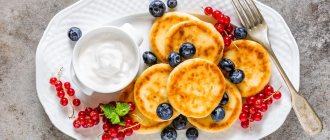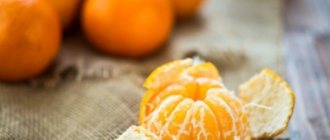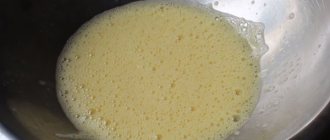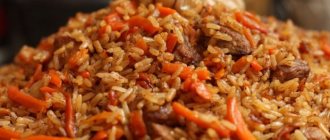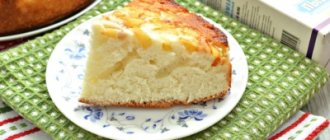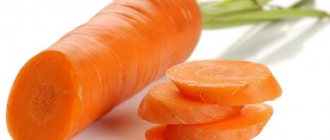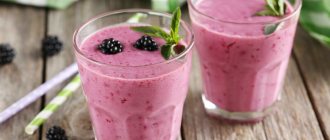The benefits and harms of cheesecakes during breastfeeding
To understand whether a dish is healthy or not, you need to look at its components. Classic cheesecakes include cottage cheese, eggs, a little flour or semolina. Salt and sugar are also added to the dish, but the amount of these ingredients is insignificant, and they do not affect whether it is beneficial or harmful.
Cottage cheese
Cottage cheese as the basis of a dish is very useful for nursing mothers. It contains a lot of calcium, which is simply necessary for a woman who has carried and given birth to a child. It helps restore bones, tooth enamel, hair, nails - all this is primarily affected during pregnancy. Calcium also penetrates into breast milk, due to which the baby’s skeletal system is strengthened.
The milk protein in cottage cheese is in a special “curdled” state. This is good, since in this form it practically does not cause allergies and is easily accepted even by a fragile child’s body. Protein food is very important during breastfeeding, as it provides the body of a woman and child with the main building material. The protein contained in cottage cheese is perfectly absorbed by women and children.
Thanks to its low calorie content and excellent nutritional properties, cottage cheese will be useful even for those mothers who are trying to regain their former shape after childbirth.
The beneficial substances contained in the product help increase the speed of metabolic processes in the body.
Despite all the beneficial properties of the product, you need to be aware that it is impossible to provide all the body’s needs with cottage cheese alone. Therefore, cheesecakes for a nursing mother are an excellent dish to diversify the diet, but it is important to remember to have a balanced diet and eat not only animal, but also plant protein, as well as vegetables, fruits, lean meat and fish as a source of valuable amino acids.
Few people know that cottage cheese has a pronounced diuretic effect. If mommy suffers from edema, then this product will be extremely useful for her. Otherwise, you need to be careful and limit the portion of the product, since breastfeeding requires a sufficient amount of liquid in the diet to restore normal water balance in the body. And excessive consumption of cottage cheese can upset this balance due to its diuretic properties.
It is not recommended to abuse cottage cheese for people suffering from diseases of the kidneys and genitourinary system, for example, urolithiasis. An excess of animal proteins in the diet triggers a mechanism for increased calcium excretion from the body. Because of this, the load on the kidneys increases many times over.
Eggs, semolina and flour
Chicken eggs are a strong allergen, so their presence in dishes in the first months of breastfeeding is undesirable. Before you try to introduce cheesecakes into the diet, you need to familiarize the child’s body with each ingredient separately. Mommy can eat half a boiled egg for breakfast for several days and watch the baby’s reaction. If there is no allergy, then you can safely introduce dishes with eggs into your diet.
If we talk about flour and semolina, these products are made from wheat and contain gluten, a protein that not every body can digest. Of course, gluten intolerance is not so common, but it should not be ruled out. A nursing mother can introduce cereals and products containing this protein into the diet no earlier than the second or third month of the baby’s life. Since there is not very much flour and semolina in cheesecakes, negative reactions in a child are unlikely, especially if you observe moderation in portions. However, it is necessary to exercise caution, especially in the first months of breastfeeding.
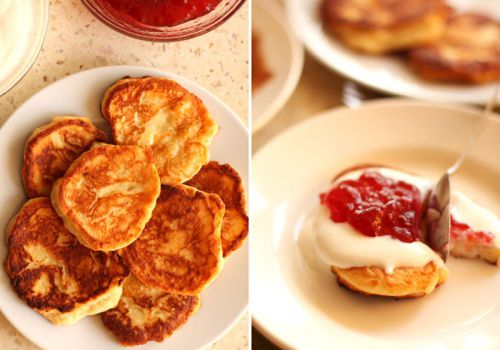
If gluten intolerance is still detected in the mother and child, then you can replace wheat flour with corn or rice flour. The taste of the dish will not be affected by this
Advice: It is better to choose flour for cheesecakes and any other dishes not of the highest, but of the first grade. This product is not subject to chemical refining or bleaching. Chemicals from premium flour can penetrate into mother's milk, and it is unknown how this will affect the baby.
Is it possible for a nursing mother to have cheesecakes? Of course you can! This tasty and healthy dish will perfectly diversify the diet and, if certain precautions are taken, will not harm the baby. In addition, this dish is recommended by pediatricians as complementary food for babies up to one year old. The main thing is to choose quality ingredients and the right cooking method.
How cheesecakes on a mother’s menu will affect a child
Do you love cheesecakes as much as I love them? They appear on my table at breakfast or dinner at least twice a week, when I get tired of chewing raw cottage cheese. I even somehow improved the classic cheesecake recipe and was proud of this fact for a long time, until I discovered on the Internet that I was not the only one so smart.
One day my friend and part-time nursing mother came to visit. She refused to try my culinary masterpiece because she was breastfeeding and was afraid that something might go wrong. I was really puzzled, is it really possible to make cheesecakes while breastfeeding and, as usual, I went online.
Are cheesecakes allowed while breastfeeding?
The main component of this dish is cottage cheese.
And a logical question arises: why are they called cheesecakes and not cottage cheese? In the Old Russian language there was no distinction between the names “cottage cheese” and “cheese”; all curdled products were called “cheeses”.
In Europe (France, England, Holland) cottage cheese is still called “cheese”, only when it is young. And cottage cheese is the modern name for the same cheesecakes.
To understand whether there are benefits and harms of cheesecakes during breastfeeding, you need to carefully study the composition of the product. The diet during breastfeeding must contain calcium, protein and phosphorus. All these components are present in cottage cheese, so a nursing mother can eat it.
But you also need to know that cottage cheese alone cannot provide all the body’s protein needs; everything should be in moderation. Few people know, but this is a fact - cottage cheese has a diuretic property. Consuming it in large quantities will only be beneficial if you suffer from edema.
Otherwise, its excess in the body can negatively affect lactation, since it requires a fairly large amount of fluid in the mother’s body.
Also, cottage cheese in large quantities is extremely unhealthy for women (and men too) who have kidney problems. After all, an excess of animal proteins triggers the process of increased calcium excretion from the body.
The load on the kidneys increases, and this threatens urolithiasis.
Precautionary measures
The most important difference between cottage cheese and milk is that the protein contained in cottage cheese is in a coagulated state. This makes it more easily digestible and does not cause an allergy in the child to foreign protein, as in whole cow's milk. But nevertheless, it is better not to eat cottage cheese dishes in the first month. It is worth introducing them into the mother’s diet during the 2-3rd month of breastfeeding.
You need to start, as usual, with a small piece in the first half of the day, so that you have the opportunity to see the baby’s reaction. If the baby’s tummy reacts normally to the new product, then you can eat cheesecakes while breastfeeding without fear.
One big and important BUT! This is a homemade dish only. No store-bought convenience foods! You don’t know where, how and from what products this delicacy was prepared.
You can get poisoned very easily with this product.
Start with the simplest cheesecakes without additives, and only when the child’s tummy gets used to the new product can you gradually add dried fruits, apples or bananas to the dough.
How to properly introduce cheesecakes into the diet during breastfeeding
To enjoy a dish like cheesecakes without fear, you need to follow a few tips for introducing them into your diet during breastfeeding:
- Cheesecakes should be introduced into the mother’s menu no earlier than 2-3 months after the baby’s birth.
- The first portion should be small - no more than one cheesecake. It is best to eat it for breakfast to observe the child’s reaction during the day.
- If the baby responded well (no allergies or tummy discomfort appeared), then you can gradually increase the portion size, but do not eat more than 3 (100-150 g) small cheesecakes at a time.
- If there is a negative reaction, the dish should be strictly excluded from the diet and try to return to it after 3-4 months.
- Don't overeat! Excess food, even healthy food, will bring nothing but intestinal problems for both mother and baby.
- You need to make your own cheesecakes using high-quality ingredients. Store-bought semi-finished products are not suitable for a nursing mother's menu!
- Cottage cheese and other ingredients must be fresh - this is important! An expired product will not only negatively affect the taste of the dish, but can also lead to poisoning.
- You cannot buy cottage cheese with palm oil in it. Not only can this product cause colic in a baby, but the cheesecakes will fall apart when cooked.
- It is best to prepare the cottage cheese yourself, but if you don’t have time, then you only need to buy a fresh product in the store with a minimum shelf life and a fat content of up to 9%. Too fatty cottage cheese can cause constipation or colic in a baby.
- At first, it is better not to add berries, dried fruits and other additives to the dish. When the baby’s body gets used to simple cottage cheese, it will be possible to gradually introduce more complex recipes into the diet.
- For a nursing mother, unsweetened cheesecakes filled with stewed vegetables (pumpkin, zucchini, cauliflower, broccoli, carrots) will be most beneficial.
- You cannot add chocolate sauces, store-bought syrups, etc. to the dish. Such supplements are unhealthy and contain a large amount of “chemicals”. It is better to limit yourself to a spoonful of low-fat sour cream or high-quality apple jam.
Tips for nursing mothers on eating cheesecakes
- You can introduce cheesecakes to a nursing mother in the second or third month of breastfeeding;
- For the first time, try a small piece of up to 10 grams and observe the baby’s reaction for two days. If the body reacts normally, cheesecakes can be eaten while breastfeeding without fear;
- If your baby begins to have stomach problems, a rash or another negative reaction, remove cheesecakes from the diet and consult a doctor. Read more about how to help your child with allergies here;
- Do not overeat, otherwise it will lead to digestive problems for both the baby and the nursing mother! The daily norm of cheesecakes is 100 grams or 4-5 pieces of medium size, the weekly norm is up to two times;
- Eat cheesecakes in the morning. They will become a nourishing and tasty breakfast dish for a nursing mother;
- Carefully choose products for preparing a dish, monitor the quality and expiration date of cottage cheese, eggs, flour and other ingredients;
- Do not buy store-bought cheesecakes, as they can lead to severe poisoning due to the presence of chemicals and other third-party ingredients! Cook at home!;
- At first, when breastfeeding, eat simple cheesecakes without additives. When the digestion of the baby and mother get used to the new dish, you can add dried fruits one by one (dried apricots, raisins, prunes and dates are suitable), apples and bananas, pears and nuts;
- A good dish for a nursing mother would be unsweetened cheese pancakes with vegetable filling (you can use carrots, cauliflower, zucchini, pumpkin, etc.)
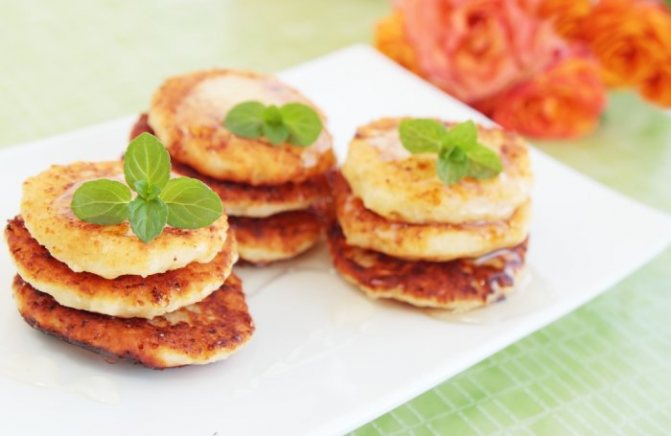
Tips for preparing cheesecakes for a nursing mother's diet
When breastfeeding, it is important not only to choose the right foods, but also to choose a method of preparing food that will make the dish healthy. It is best to cook cheesecakes in the oven or steamer. This method not only saves time, but also allows you to use a minimum amount of oil. It is necessary to avoid large amounts of fat in food, as fatty foods cause colic and constipation in the child.
To make the cheesecakes soft and crumbly, you need to remove excess water from the cottage cheese. To do this, you need to put it in a colander or cheesecloth and wait until the excess moisture drains. If the cottage cheese, on the contrary, is too dry, then you can add a small amount of low-fat sour cream or natural yogurt to it.
Immediately before preparing the dish, it is better to beat the cottage cheese with a blender or rub through a fine sieve. This way you can achieve a uniform airy consistency of the dough, and the finished dish will be airy. For frying, it is better to use refined olive oil. This product, unlike sunflower, does not emit carcinogens. The frying temperature is 120 degrees, and the temperature at which olive oil releases carcinogens is 242 degrees.
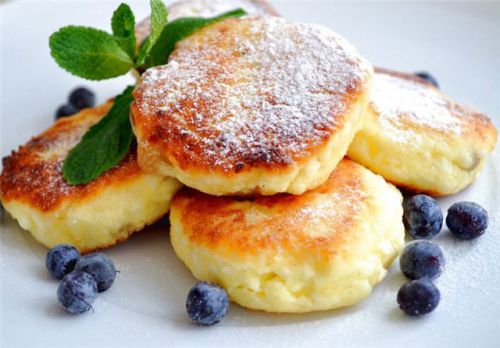
To get an appetizing golden brown crust, you can fry the curds in a frying pan, but choose dishes with a non-stick coating - this will also allow you to use less oil
How to cook cheesecakes correctly
When cooking, follow the proportions of flour and cottage cheese. If necessary, you can add semolina or use it instead of flour. For frying, use fresh sunflower or olive oil.
Cheesecakes are cooked in a frying pan, in the oven or in a double boiler. To prevent them from turning out “rubbery”, you need to remove excess moisture from the cottage cheese. To do this, place the product in a colander and wait until the liquid drains. But dry cottage cheese can be softened with natural yogurt or kefir.
Many people recommend using semolina instead of flour, then the cheesecakes will be soft and not sticky. However, be careful, as the cereal contains the allergenic gluten, which is not recommended for breastfeeding. But if the baby has no problems, semolina can be eaten in small and rare quantities. For more information about eating semolina, read the link https://vskormi.ru/mama/mannaja-kasha-pri-grudnom-vskarmlivanii/.
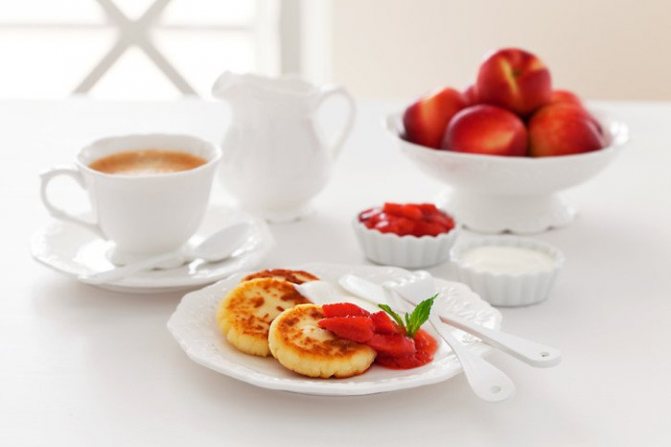
Regular cheesecakes can be served with honey, fresh berries and fruits, if the baby does not have allergies. Before preparing the dish, the cottage cheese is ground in a blender and pureed to the consistency of a creamy paste. As a result, you will get tender and airy cheesecakes! By the way, it’s better to cook cottage cheese yourself. This way, you will be confident in the composition and safety of the future dish. Read on to find out how to do this.
Cheesecake recipes for nursing mothers
Cheesecakes in the oven
Ingredients:
- Cottage cheese – 500 g.
- Chicken egg – 2 pcs.
- Flour – 5 tablespoons.
- Baking powder – 0.5 teaspoon.
- Unsweetened yogurt – 125 g.
- Sour cream 10% – 3 tablespoons.
- Granulated sugar – 2-3 tablespoons.
Preparation: Mix all ingredients and beat in a blender. Place the dough into molds. If you use silicone molds, you do not need to grease them with oil; metal molds can be lightly sprinkled with vegetable oil so that the cheesecakes do not burn. Bake in the oven for 30 minutes at 180-900 degrees.
